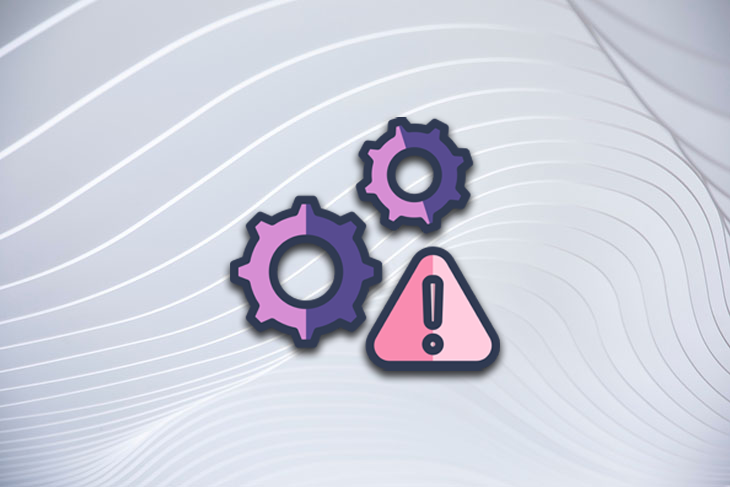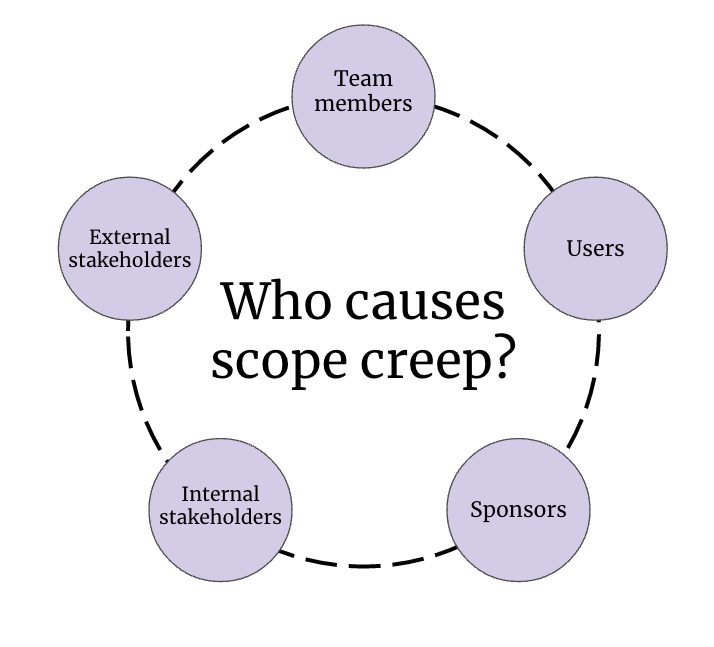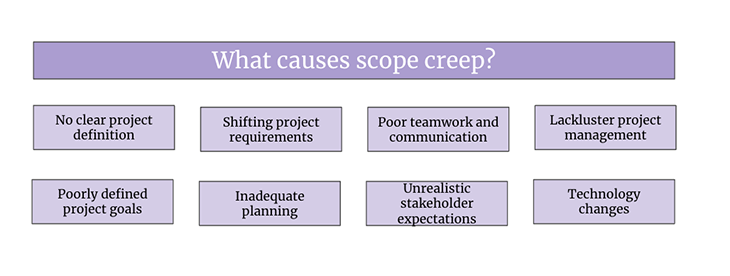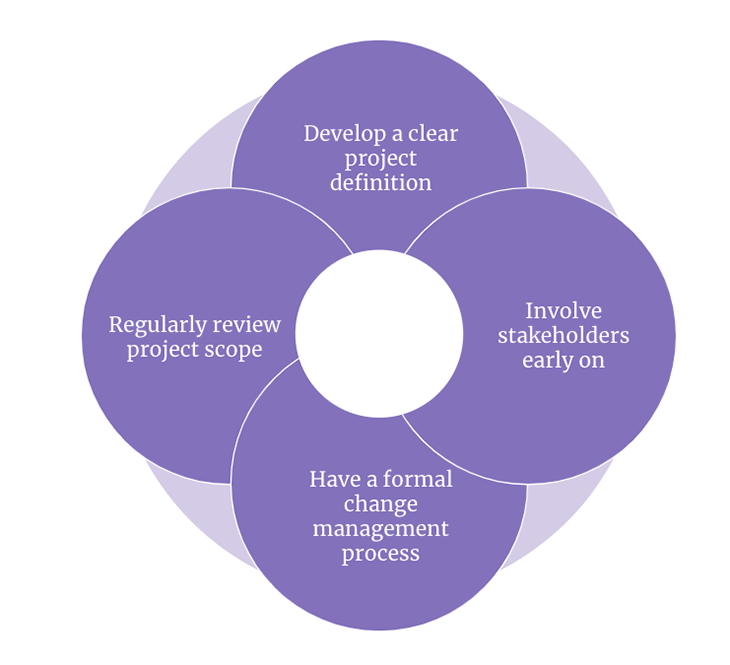Customers complain about missing features. The project exceeds its calculated budget. Quality drops and the team is on the verge of burnout. Does this sound familiar?

All these symptoms can have their origin in one single cause — scope creep.
When I took over the role of head of software a few years ago, I didn’t know what kind of problems our team was facing in some projects. In the beginning, the projects were all very good. We went into them with our customers and were full of energy and enthusiasm to deliver good products.
After a while, the previously positive atmosphere changed to a rougher tone in some projects. The reason was poor project management and expectation management, all characteristics of scope creep.
In this article, we’ll learn how scope creep can affect your project plan and how to avoid it.
Scope creep is a term used in project management when a project’s scope or requirements change over time, leading to increased project timelines, costs, and potential for failure. This can happen when stakeholders request additional features or changes beyond the original project scope, without considering the impact on project resources or timelines.
Scope creep can be managed through effective project planning and communication. Though that sounds daunting, there are many things you can do that seem insignificant but have a big impact over time. These include setting clear project goals, clarifying the boundaries of the project scope, communicating scope and boundaries to all stakeholders, and generally engaging with key stakeholders regularly.
In project management, I have made it a habit to hold regular status update meetings with my team and key stakeholders. We meet every two weeks for a 20-minute session and update KPIs like project progress, key milestones, and, most importantly, the overall project status, which we visualize as a traffic light.
Green means everything is going according to plan, amber means there is a risk that the project plan cannot be met (i.e., we are late), and red means the plan cannot be met. When a project is affected by scope creep, it is interesting to observe that important KPIs slip from green to amber over time, because the execution of the project is delayed and important milestones probably cannot be done in time.
As a result, scope creep is more noticeable when the planes are tight. It can also have negative effects on a project before the scope creep is even identified:
It can:
Scope creep always leads to a higher workload than was originally planned. New functionality creeps in and takes time to implement, leading to delays. Increased costs caused by the new functions and features have to be paid for by someone.
As you can probably conclude, scope creep also leads to stakeholder dissatisfaction and the perception that the project is not successful. The original plan cannot be fully realized and that can be a bad look.
Everyone involved in a project can cause scope creep. Here are some common examples:

If it isn’t obvious, team members can cause scope creep by adding unnecessary features without proper approval or consideration of the project’s objectives and limitations. A special type of this form of scope creep is called gold plating. Team members refine and improve features unnecessarily and increase the scope unconsciously.
To avoid this type of scope creep, I find it useful to remember the specific team members of the project scope, the timeline, and the minimum requirements of the project regularly. It is often a technician’s mindset to improve things, that is why we talk about our strategy for the implementation of the project in the beginning. Our strategy is often to satisfy the basic requirements first, and if there is still time at the end of the project, we can improve functionality.
Users can cause scope creep by requesting additional features that were not originally planned for or included in the project scope.
In my experience, getting users to test your solution and give you feedback is difficult at first. Plan enough time for this task and prepare it well. Once they try your solution and you reach a point where users like it, it’s hard to avoid being overwhelmed with feature requests and ideas. If you don’t handle this feedback properly and don’t consider your original plan, you can easily end up in feature hell and exceed your project scope.
To avoid these types of scope creep, try to remind yourself and the team to stay focused on the plan. If needed, you can talk with the project sponsor and key in a project scope change request.
Project sponsors are the most influential stakeholders of a project. They are responsible for the adequate resource allocation and funding of a project.
Sponsors can cause scope creep by changing their requirements, adding new features, or requesting additional work without considering the impact on the project’s timeline, budget, or resources.
Because they are influential, it is often difficult for the project manager to turn down the sponsors, and additional requirements lead to an expansion of the project scope.
To avoid sponsor scope creep, project managers should make the additional effort transparent and explain the consequences of such requirements. If it is unavoidable to turn the request down and implement the new feature, it’s advisable to document the change request, update the project plan, and communicate the updated plan to all stakeholders, including the sponsor.
Internal stakeholders can cause scope creep by changing their requirements, adding new features, or requesting additional work without considering the impact on the project’s timeline, budget, or resources.
Internal stakeholders are people (or groups of people) within the same organization who have a major impact on the project. For example, administration and management, IT, or other adjacent project teams are all examples of internal stakeholders.
For example, in one of our last projects, we had dependencies on another team’s infrastructure services. The required interface to our solution changed technically right before the end of the project. We had to change the way we authenticate, resulting in significant additional work for us.
Another example would be if administration needs additional reports from the project team members. This can lead to additional time spent on organizational tasks and not on development tasks.
To avoid this, keep your stakeholders close. Update them on your timing plan and agree on defined interfaces.
External stakeholders can cause scope creep by introducing new requirements to the project scope that were not originally planned or included in the project scope. External stakeholders can be other project teams of other organizations, the producers of infrastructure the project builds on, or governmental organizations.
For example, a project may depend on a government service or interface. Changes to the interface or requirements can lead to scope creep on the project.
This is probably the most difficult type of scope expansion to avoid, as it is often beyond our control when such things change. When possible, keep stakeholders close and maintain communication.
If you look at who is causing scope creep, you can see how broad the topic is and how difficult it is to prevent it. Practically everyone involved can cause scope creep, consciously or unconsciously. And although scope creep can be triggered by various factors, here are the eight points that have had a particularly strong influence on our projects:

Often, the seed for scope creep is sewed right at the beginning of a project and starts with a bad or missing project charter. When project milestones, requirements, and scope are not clearly defined at the beginning of the project, it can lead to misunderstandings and disagreements among stakeholders about what the project is meant to achieve.
This lack of clarity can cause stakeholders to request additional features or requirements that were not part of the original plan, leading to scope creep. Consider all the key elements of a good project plan and define the scope and project definition in the form of a project charter.
Speaking off of personal experience, before we introduced a clear project charter as a must before starting a project, we often had that problem — there were misunderstandings and different opinions about how the project should be structured and what the overall scope and goal of a project should be.
These misunderstandings often led to unhappy stakeholders and customers. Then, we introduced project charters to eliminate these misunderstandings before the start of new projects and to clarify the most important elements and goals. Though misunderstandings still happened, we were able to address them directly and early by writing and discussing the project charters.
As a project progresses, stakeholders may change their requirements, expectations, or priorities. These changes can result in additional work added to the project, leading to scope creep. If a stakeholder requests a new feature mid-way through the project, the project team has to adjust their plans and add additional work to the project.
One of the hardest things is saying no to good ideas and good feature requests. But to stay true to the project plan, you have to say no, or you have to create change requests and update your budget, timeline, and plan. Telling stakeholders how much effort it will take to do that might also prevent new feature requests.
Poor communication and team collaboration can also contribute to scope creep. When stakeholders do not communicate effectively about changes or requirements, it can lead to misunderstandings and the addition of extra work. If the project team is not aware of a stakeholder’s changing requirements, they may continue to work on the original plan, leading to additional work when the change is communicated.
Another example is when the team does not communicate well internally and duplicates work that was only scheduled once. For example, when infrastructure code is programmed twice.
When the project manager does not establish clear project goals, timelines, and milestones, or when they do not monitor progress closely, it can lead to additional work.
If the project manager is not aware of how much work the project team is doing, they may not be able to manage stakeholder expectations or make necessary adjustments to keep the project on track. Good project managers know what is in the scope and what is not. And they protect the project and fight to keep the scope as good as they can.
In some cases, it does make sense to change the scope, and then a formal change request should be made.
When project goals are not clear, it can lead to confusion about what the project is meant to achieve. This lack of clarity can lead to stakeholders requesting additional features or requirements that were not part of the original plan.
I personally always use the SMARTER model to set, evaluate and review goals. In this case, SMARTER stands for specific, measurable, achievable, relevant, time-bound, evaluated, and reviewed. By considering these points, project goals are specific and tangible and leave no room for interpretation, thereby preventing misunderstandings with our stakeholders.
Poor planning can also contribute to scope creep. When the project team does not account for all potential requirements or dependencies, additional work is added to the project later. The key is to break the project down into manageable parts that are small, manageable, understandable, and low in complexity. Then, these parts can be better estimated individually and better planned in the project plan.
Stakeholder expectations can also contribute to scope creep. If stakeholders are not clear on what the project is meant to achieve, or if they have unrealistic expectations about what is possible, they may request additional work or features that were not part of the original plan.
In my opinion, contradictory stakeholder expectations can easily be countered at the beginning of the project with a good project charter. It is important to clarify expectations right at the beginning, even before the project starts.
Changes in technology can also cause scope creep. When new technologies or platforms become available, stakeholders may request that they be integrated into the project.
To prevent this from happening define a technology stack at the beginning of your project and let the stakeholders approve it. But, even on a smaller scale, technical requirements can change. For example, a technical interface to a third-party system can change and, thus, lead to scope creep.
Scope creep can lead to various negative consequences, such as project delays, increased costs, decreased quality, stakeholder frustration, and team burnout. It can also lead to miscommunication and unclear expectations, resulting in conflict and strained relationships between stakeholders.
To avoid these consequences, it’s important to establish clear project objectives and requirements, monitor progress regularly, and communicate changes effectively. Here are the common consequences:
Scope creep can cause delays and increase the project timeline. When additional work is added beyond the original scope, completing the project can take longer.
For example, if a new feature is added mid-way through the project, the project team may have to adjust their plans, allocate additional resources, and spend more time on the project.
Scope creep can also lead to increased project costs. When additional work is added beyond the original scope, it can require additional resources, including time, labor, and materials.
For example, if a new feature is added mid-way through the project, it may require additional software development or hardware, increasing the project’s costs. Or, if the team needs to pull in more resources to make the feature happen, they may be paying for the labor of engineers who are stepping away from other responsibilities to work on this project.
Scope creep can also lead to a decrease in project quality. When additional work is added beyond the original scope, it can lead to a loss of focus and a lack of attention to detail.
For example, if the project team is working on new features, they may not be able to allocate enough time and resources to complete the original work.
Scope creep can also lead to decreased stakeholder satisfaction — it can lead to a perception that the project is unsuccessful, as the original goals are not fully achieved.
For example, if stakeholders were expecting the project to be completed within a certain timeline or budget, scope creep can cause disappointment and dissatisfaction if the project is delayed or exceeds the budget. Additionally, if stakeholders feel that their needs were not met, they may be less satisfied with the final product.
You may think that scope creep is something that only inexperienced project managers have to deal with. After all, an experienced project manager can make a good plan and manage their stakeholders closely, involve them, and maintain regular communication with important key stakeholders.
But many underestimate why scope creep is so great at being creepy.
Imagine you’ve just completed the first milestone of your project, and now you’re gathering feedback from various stakeholders and users on the features, as expected in the project plan. So you communicate with your stakeholders, set the exact expectations on how and what you want to get feedback on, and set a time frame for these discussions. To keep to the time frame, you limit the number of conversations to 20.
At the end of the week, the time is almost used up and you finish the last meeting early.
But, then, you receive a request from an important stakeholder. They now have time and would like to give you their feedback on the first milestone. To be rude (and because it is an important key stakeholder), you agree.
When you go into the feedback meeting, you suddenly find yourself sitting across from five other employees who all come from the same department as the key stakeholder. They don’t feel heard and say they are missing an important key feature.
Since the feedback meeting is not enough, further follow-up meetings are arranged. In the third follow-up meeting, you can just about fend off the desired feature with a small, already existing workaround. You have managed to prevent the feature, but the many meetings have delayed your further plans. Scope creep has caught you.
To prevent scope creep in a project, it is important to:

This all involves defining the project goals, objectives, deliverables, timelines, and budget at the outset, engaging stakeholders in the project planning phase, outlining how changes to the project scope will be managed, and reviewing the project scope regularly.
By following these steps, the project team can ensure that all stakeholders are aligned on the project’s goals and objectives and that changes to the project scope are managed in a controlled and structured manner.
Developing a clear project plan based on the project charter is essential to preventing scope creep. This includes defining the project goals, objectives, deliverables, timelines, and budget. By establishing a clear project definition at the outset, stakeholders will better understand what the project entails and what is not included. This clarity can help prevent misunderstandings and disagreements that can lead to scope creep. When defining deliverables, ensure you also define critical success factors, success criteria, and key performance indicators.
Involving stakeholders early on in the project can also help prevent scope creep. This includes engaging stakeholders in the project planning phase and getting their input on project goals, requirements, and expectations.
By involving stakeholders early on, the project team can ensure that all stakeholders are aligned on the project’s goals and objectives. To include all key stakeholders in your communications, it’s best to use a stakeholder interest x influence matrix. This way, you can identify the most important stakeholders with whom you need to work closely.
Having a formal change management process in place can also help prevent scope creep. This process should outline how changes to the project scope will be managed, including how changes will be identified, evaluated, and approved.
The project team can ensure that all changes to the project scope are evaluated against the project goals, timelines, and budget and that all stakeholders are aware of any changes made. A simple change process consists of three parts:
Regularly reviewing the project scope can help prevent scope creep. This includes reviewing project goals, objectives, timelines, and budgets regularly to ensure that the project is on track and that all stakeholders are aligned on the project’s goals and objectives.
By reviewing the project scope regularly, the project team can identify any changes or issues early on and address them before they become bigger problems.
Scope creep is a common problem in project management that occurs when the scope of the project expands beyond its original boundaries, resulting in missed deadlines, budget overruns, and decreased quality. It can be caused by a variety of factors, including inadequate planning, poor communication, and stakeholder demands.
To prevent scope creep, you should establish clear project scope, communicate the scope to all stakeholders, and implement effective change management processes.
It is also important to monitor the project closely and identify any signs of scope creep early on so that corrective action can be taken as soon as possible.
By taking these steps, you can prevent scope creep and ensure the project is completed on time, within budget, and to a high level of quality.
Featured image source: IconScout

LogRocket identifies friction points in the user experience so you can make informed decisions about product and design changes that must happen to hit your goals.
With LogRocket, you can understand the scope of the issues affecting your product and prioritize the changes that need to be made. LogRocket simplifies workflows by allowing Engineering, Product, UX, and Design teams to work from the same data as you, eliminating any confusion about what needs to be done.
Get your teams on the same page — try LogRocket today.

A practical framework for PMs to use AI in ideation without sacrificing judgment, strategy, or decision quality.

A practical five minute revenue estimation method to help product managers compare ideas, drop low impact features, and prioritize smarter.

A practical guide for PMs who want to stop being bottlenecks, delegate smarter, and lead teams effectively with a clear ownership framework.

Stop letting unreliable data block features. Treat data as inventory to track quality, ownership, and ship with confidence.